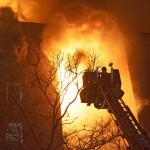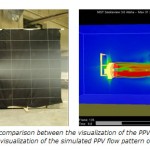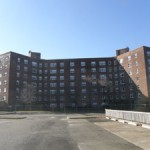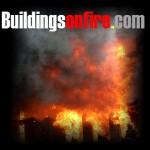Multiple Alarm Operations with Wind Driven Fire
By Christopher J. Naum, SFPE on Feb 21, 2011 with Comments 0
The five alarm fire that ran through a seven story multiple occupancy (MO) apartment building in the Flatbush Section in the Borough of Brooklyn (NYC) this weekend considerably challenged operating companies of the FDNY as the fire was fueled and spread in rapid success due to significant wind conditions compounded by news reports that a door to the fire compartment was left open, thus allowing the developing fire conditions to intensify and escalate due to the wind driven conditions that were impacting the building, the fire compartment and initial operating companies.
The seven-story MO Apartment building at 346 East 29th Street is reported to have had 70 apartments and was located midway in the city block. Arriving companies reported a fire on the number four floor and quickly deployed handlines and initiated primary search and rescue and other tactical assignments.
First-due operations, from the initial alarm assignment’s arrival, the transmission of size-up communications and the accurate and timely deployment of companies to task assignments is mission critical to an evolving incident.
The introduction of other challenges such as confronted by FDNY at this alarm further magnify the importance of effective command risk assessment, building size-up, effective and efficient company assignments and deployments with adequate resources (staffing and companies) to intervene with the fire dynamics and growth of an initial developing room and contents to an extending and escalating structure fire.
[youtube]http://www.youtube.com/watch?v=zS878FJ1N74[/youtube]
Take a few minutes to listen to the radio transmissions on the audio file attached, paying particular attention to the exchange of dispatch communications, first-due size-up and actions, command transmissions and subsequent rapid transmittal of greater alarms, as fire ground operational conditions deteriorated due to the wind driven fire, fire extension, civilian’s in distress and rescue operations.
Think about the way you would react, interface or address similar conditions and challenges at an alarm in your jurisdiction or department.
- Do you have the necessary skills and experience to address timely actions required of company and command officers at a wind drive fire incident?
- Are you capable of addressing a large single family dwelling, or a large low rise MO apartment building? How about a townhouse or garden apartment complex building?
- How familiar are you with strategic and tactical considerations wind drive fire incidents?
- Are you aware of the recent research and operational factors and considerations coming out of emerging research from the NIST and UL?
- How effective are your capabilities for operating at large scale multiple alarm incidents with your department’s resources, or with mutual aid or external agencies?
- Have you trained and prepared to manage multiple alarm incidents?
Take some to time to gain some insights from this alarm; the communications and the challenges and make this a learning opportunity to gain some insights into wind drive fire theory and operational considerations.
Here’s some mission critical links and references to make you a more effective and capable company and command officer.
National Fire Academy On-Line Training Program
Awareness of Command and Control Decision making at Multiple Alarm Incidents (Q297) 1.5 CEUs Enroll Now »
- This course is both a stand-alone course as well as the pre-course for the 6-day residential delivery of the National Fire Academy’s new Command and Control Decision Making at Multi-Alarm Incidents. Anyone interested in applying for the 6-day residential course must pass this pre-course with a score of 85 percent. The topics covered in this pre-course include: classical and naturalistic decision making, strategies for managing safety concerns at expanded emergency incidents, pre-incident preparation, resource allocation, effective use of on-site communications, set-up of an incident command post and post incident analysis.
NIST: Fire Fighting Tactics Under Wind Driven Fire Conditions: 7-Story Building Experiments. HERE
February 2008, a series of 14 experiments were conducted in a 7-story building to evaluate the ability of positive pressure ventilation fans, wind control devices and external water application with floor below nozzles to mitigate the hazards of a wind driven fire in a structure. Each of the 14 experiments started with a fire in a furnished room. The air flow for 12 of the 14 experiments was intensified by a natural or mechanical wind.. Each of the tactics were evaluated individually and in conjunction with each other to assess the benefit to fire fighters, as well as occupants in the structure. The results of the experiments provide a baseline for the hazards associated with a wind driven fire and the impact of pressure, ventilation and flow paths within a structure. Wind created conditions that rapidly caused the environment in the structure to deteriorate by forcing fire gases through the apartment of origin and into the public corridor and stairwell. These conditions would be untenable for advancing fire fighters. Each of the tactics were able to reduce the thermal hazard created by the wind driven fire. Multiple tactics used in conjunction with each other were very effective at improving conditions for fire fighter operations and occupant egress. Fire departments that wish to implement the tactics used in this study will need to develop training and determine appropriate methods for deploying these tactics. Variations in the methods of deployment may be required due to differences in staffing, equipment, building stock, typical weather conditions, etc. There is uniformity however, in the physics behind the wind driven fire condition and the principles of the tactics examined. The data from this research will help provide the science to identify methods and promulgation of improved standard operating guidelines (SOG) for the fire service to enhance firefighter safety, fire ground operations, and use of equipment. The experiments were conducted by the National Institute of standards and Technology (NIST), the Fire Department of New York City (FDNY), and the Polytechnic Institute of New York University with the support of the Department of Homeland security (DHS)/Federal Emergency Management Agency (FEMA) Assistance to Firefighters Research and Development Grant Program and the United States Fire Administration.
![]() Fire Fighting Tactics Under Wind Driven Fire Conditions: 7-Story Building Experiments. (58118 K)
Fire Fighting Tactics Under Wind Driven Fire Conditions: 7-Story Building Experiments. (58118 K)
Kerber, S. I.; Madrzykowski, D.
NIST Wind Driven Fires Studies, HERE
Smoke and heat spreading through the corridors and the stairs of a building during a fire can limit building occupants’ ability to escape and can limit fire fighters’ ability to rescue them. Changes in the building’s ventilation or presence of an external wind can increase the energy release of the fire. This can also increase the spread of fire gases through the building. In some cases, such as the Cook County Administration Building fire in October 2003, the fire gas flow, into the corridors and the stairway prevented fire fighters from suppressing the fire from inside the structure. This fire resulted in 6 building occupant fatalities and fire fighter injuries in the stairway. The Fire Department of New York City has experienced many wind driven fire incidents which have resulted in fire fighter fatalities and injuries.
Postings from Buildingsonfire.com
Direct link to the Wind Driven Fire Research Postings on Buildingsonfire.com HERE
NIST Wind Driven Fire Simulation Video
NIST Wind Driven Fire Simulation Video Wind Driven Fires Smoke and heat spreading through the corridors and the stairs of a building during a fire can limit building occupants’ ability to escape and can limit fire fighters’ ability to rescue them. Changes in the building’s ventilation or presence of an external wind can increase the […]
Positive Pressure Ventilation Research
Positive Pressure Ventilation The objective of this NIST research is to improve firefighter safety by enabling a better understanding of structural ventilation techniques, including positive pressure ventilation (PPV) and natural ventilation, and to provide a technical basis for improved training in the effects of ventilation on fire behavior by examining structural fire ventilation using full-scale fire experiments with and […]
NIST Wind Driven Fires Programs
Wind Driven Fires Wind blowing into the broken window of a room on fire can turn a “routine room and contents fire” into a floor-to-ceiling firestorm. Historically, this has led to a significant number of firefighter fatalities and injuries, particularly in high-rise buildings where the fire must be fought from the interior of the structure. […]
Wind Driven Fires
A million dollar Baltimore County, Maryland home was destroyed Sunday December 13, 2009 by a fire that tore through the 4,700-square-foot structure with such intensity that firefighters were forced to battle the flames from the exterior. Shortly after 21:00 hours, Baltimore County Fire Dispatch alerted crews for Fire Box 50-2 at 12607 Nancy Lee Court […]
Tactical Patience and the New Considerations of Ventilation on Fire Behavior in Legacy and Contemporary Residential Construction on CommandSafety.com HERE, with insights into the new UL Impact of Ventilation on Fire Behavior in Legacy and Contemporary Residential Construction
ALARM INFORMATION
FDNY Brooklyn, N. Y. 02/19/11 @ 18:45 hrs.
Flatbush Section Box 2439 address: 346 East 29th St. between: Ave. “D” & Clarendon Rd.
2439 @ 18:42
Engs. 255, 281, 217 act. 310
T. Lad. 157, Lad. 147
Batt. 41
10 – 75 – 2439 @ 18:46
Ladder 113 is designated as the “FAST” Truck
Eng. 249
Rescue Co. #2
Squad Co. #1
Batt. 48
Division 15
Fire Building:
6 Story Brick 100 x 100 O/M/D ( orig. reported )
7 Story Brick 100 x 100 O/M/D ( actual size up )
All – Hands:
7 – 5 – 2439 @ 18:48
Batt. 41 reports: All – Hands upon arrival, extra Engine & Truck
Fire 4th floor of a 6 Story Brick occupied multiple dwelling
Engine 250 / Ladder 174 s/c
“Batt. 41 to Brooklyn, Transmit a 2nd Alarm, We also transmitting a 10-70 ( water relay )
2nd Alarm:
2 – 2 – 2439 @ 18:53
Engs. 310, 240, 283 ( Eng. 310 designated Water Resource Unit )
T. Lad. 159, Lad. 149
Eng. 284 w/ Satellite 3
Batt. 38 “Safety Officer”
Batt. 33 “Resource Unit Leader”
Rescue battalion / Safety Battalion
Fieldcom 1 / Tactical Support Unit #2
@ 18:58
Batt. 41 to Brooklyn, We have a “May-Day” transmitted from the Fire Apt. We’re putting the “FAST” Truck to work. Assigned another “FAST” Truck, Tower Ladder 159 is assigned new “FAST” Truck
@ 19:13
Division 15 reports: “May-Day” member located and removed from Fire Bldg. We have fire on the 4th & 5th floors out the rear.
4 – lines stretched, 4 – lines in operation. Fire’s Doubtful.
3rd Alarm:
3 – 3 – 2439 @ 19:15
Engs. 309, 323, 257, 330
Lad. 123, T. Lad. 170
Batt. 58
Batt. 44 “Staging Manager”
Air Re-Con Chief “grounded” due to winds
Mask Service Unit #1
Staging Area: Clarendon Rd. & Nostrand Ave.
@ 19:20
Division 15: Box 2439, We have fire on the 4th; 5th; & 6th floors and into the Cockloft. All members being removed from the upper floors, setting up the Tower Ladders.
@ 19:27
Special Call ( 2 ) additional Battalion Chief’s
Batt. 40 act. 58, Batt. 32 are s/c
@ 19:30
Special Call a “High Rise Nozzle Co.” Eng. 254 assigned
@ 19:36
Special Call ( 2 ) Tower Ladders
Tower Ladder 144 act 153 & Tower Ladder 120 are s/c
4th Alarm:
4 – 4 – 2439 @ 19:38
Engs. 276, 220, 247, 321
Batt. 57 “Planning Chief”
Eng. 262 w/ Incident Management Vehicle
Car 4: Chief Robert Sweeney “Chief of Operations”
@ 20:39
Fieldcom 1: Progress Report for the 4th Alarm, Box 2439, Car 4, Chief Sweeney reports:
Fire in a 6 Story Brick occupied multiple dwelling. ( 3 ) Tower Ladders in operation in the rear of the Fire Bldg. ( 1 ) Tower Ladder in operation in the front of the Fire Bldg. Setting up 2nd Tower Ladder in the front of the Fire Bldg. ( 1 ) Stang in operation in the rear. Have ( 3 ) floors of fire out the rear of the Fire Bldg. Doubtful Will Hold.
@ 20:44
Fieldcom 1: By orders of Chief Kilduff, transmit the 5th Alarm.
Special Call ( 2 ) additional Engines above the 5th Alarm for “Brand Patrol”
5th Alarm:
5 – 5 – 2439 @ 20:44
Engs. 234, 280, 282, 227
Engs. 290 & 214 s/c for “Brand Patrol”
Car 3: Chief Edward Kilduff “Chief of Department”
@ 20:58
Fieldcom 1: Progress Report for the 5th Alarm, Box 2439, Car 4, Chief Sweeney reports:
Primary Searches on the 4th floor are negative except for Apt. 4 “adam”
@ 21:13
Fieldcom 1: Special Call ( 2 ) additional Trucks to the Staging Area.
Ladder 132 & Tower Ladder 111 are s/c
@ 21:22
Fieldcom 1: At this time, We’re releasing Rescue #2 & Squad #1
@ 21:26
Fieldcom 1: Progress Report for the 5th Alarm, Box 2439, Car 4, Chief Sweeney reports:
All members have been removed from the Fire Bldg. ( 3 ) Tower Ladders in operation in the front of the Fire Bldg. ( 2 ) Tower Ladders & ( 1 ) Stang in operation in the rear of the Fire Bldg. Still have heavy fire on the 4th; 5th; & 6th floors. This will be a pro long operation. Still Doubtful.
@ 22:15
Fieldcom 1: Progress Report for the 5th Alarm, Box 2439, Car 3, Chief Kilduff reports:
( 3 ) Tower Ladders in operation in the front of the Fire Bldg.
( 2 ) Tower Ladders and ( 1 ) Multi-Versal in operation in the rear of the Fire Bldg. Fire is darkening down on the 4th & 5th floors in the rear. Fire is Still Doubtful.
@ 22:58
Fieldcom 1: Progress Report for the 5th Alarm, Box 2439, Car 4, Chief Sweeney reports:
Probably Will Hold
The Bldg. has been changed to a 7 Story Bldg. Fire was on the 5th; 6th; & 7th floors and Cockloft.
@ 23:10
Fieldcom 1: Special call Eng. 233 with Mobile Command 1
@ 23:12
Fieldcom 1: Special Call ( 1 ) Division Chief, & ( 3 ) Battalion Chiefs for “relief”
Batt. 4, Batt 31 act. 41, Batt. 49 are s/c
Division 1 s/c
@ 23:18
Fieldcom 1: Special Call ( 3 ) additional Engine’s, ( 3 ) additional Tower Ladders for “relief”
Engs. 330, 248, 220
T. Lads. 107, T. Lad. 161 act. 157, T. Lad. 15 act. 131
@ 01:58
Fieldcom 1: By order’s of Division 1, Fire is Under Control.
(Job Duration: 7 hrs./16 mins.)
Note: 2 Engines, 2 Trucks, 1 Batt. Chief will be Special Called on intervals to support a “watch line”
( 1 ) 10-45 Code 1 (deceased was located in the Fire Bldg.)
Filed Under: Anatomy of Buildings • Fire Dynamics & Behavior • Graphics • Training Division • Videos

































